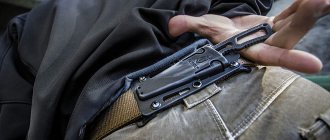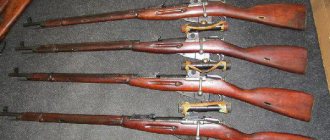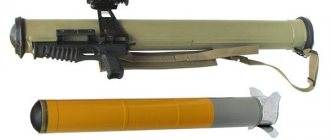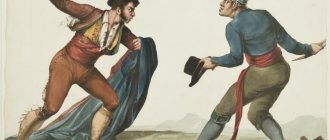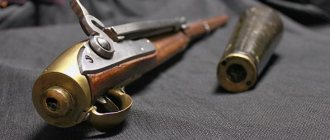Combat missions of the Russian Guard troops
VNG is one of the special rapid response units. Therefore, the range of tasks facing employees of the Russian Guard is quite wide. Many of them require fighters to use standard weapons, special tools and equipment. These include:
- Conducting special operations to neutralize various terrorist and extremist gangs.
- Security of special-purpose cargo during transportation and storage.
- Ensuring public safety during various public events, both coordinated with the authorities and unauthorized.
- Protection of important life support facilities, administrative buildings, locations of government bodies.
- Providing, if necessary, assistance to employees of other law enforcement agencies in the performance of their official duties.
- Cordoning off areas of natural and man-made disasters, sites of special operations, or work to clear mines from explosive devices.
- Ensuring the safety of important persons and persons in need of physical protection from possible assassination attempts - in accordance with a special order of the VNG command.
- Ensuring public order during the introduction of martial law or an emergency situation in a state or a particular region.
- Search and detention of criminals, saboteurs, escapees from places of detention, deserters from the armed forces.
- Suppression of illegal drug trafficking, smuggled goods, weapons.
- If necessary, VNG employees can be involved in combat operations to repel an external invasion and preserve the territorial integrity of the country (fight against separatism).
All of the above official duties may require the use of service weapons, special equipment and standard special equipment by employees of the Russian Guard.
In what cases is it permissible to use service weapons?
All cases in which shooting to kill is permitted are clearly described in the provisions of the Law “On the Police”. It is noted here that it is allowed to point combat weapons at persons who are committing an offense that is potentially dangerous to the lives of citizens, who are trying to harm animals, or take possession of infrastructure or transport.
In most cases, to prevent crime, it is enough to use a pneumatic service self-defense weapon. An open demonstration of weapons, putting them on alert, firing warning shots, and other manipulations without firing are often suitable measures to prevent the actions of attackers.
Features of the use of weapons by employees of the Ministry of Internal Affairs
According to the norms of current legislation, an employee of internal affairs bodies has the right to enter private, business and government buildings, regardless of the time of day, using cocked weapons for self-defense.
In this situation, it is allowed to destroy various structural elements with the help of weapons, which prevents further movement into the premises. In this case, notification of the owners of the object is an optional measure. Representatives of this structure are allowed to use service weapons of the Ministry of Internal Affairs when performing an operation to stop a moving vehicle. Such decisions are permitted in the presence of a potentially dangerous situation for the civilian population. If an aggressive driver continues to ignore demands to stop, mechanical damage to the vehicle using a weapon is allowed.
An employee of the Ministry of Internal Affairs also has the right to fire to kill if necessary to neutralize dangerous animals whose behavior poses a threat to the health and life of citizens.
Notes[ | ]
- Order of the Ministry of Internal Affairs of Russia No. 1020 of September 20, 2011 “On approval of the forensic requirements of the Ministry of Internal Affairs of the Russian Federation for the technical characteristics of civilian and service weapons, as well as cartridges for them.”
- Law of the Republic of Belarus No. 61-Z “On Weapons” of November 13, 2001
- ↑ 12
Decree of the President of the Republic of Belarus No. 473 of August 30, 2002 “On measures to improve the regulation of the circulation of military, service, civilian weapons and ammunition on the territory of the Republic of Belarus” - “ Firearms, depending on their purpose and technical characteristics, bivat for official or civilian purposes... For official purposes - protection of property, for self-selection, as well as for other permits, you can add and save everything else for firearms - pistols and revolvers with a length of up to 30 centimeters and up to 100 bullets of ammunition for all calibers and models of firearms, long-lasting firearms with smooth walls, which have a length of up to 51 centimeters, and up to 50 bullets of ammunition for all calibers and models of firearms.
» Decree No. 257 “Law on ordnance, ammunition, explosive substances and pyrotechnic products” (issued on September 14, 2010, in force from September 17, 2010) - Law of the Republic of Kazakhstan No. 339-I “On state control over the circulation of certain types of weapons” dated December 30, 1998
- Decree of the Government of the Republic of Kazakhstan No. 1305 of December 28, 2006 “On approval of the State Cadastre of civilian and service weapons and ammunition for them for 2007”
- Decree of the Government of the Republic of Kazakhstan No. 751 of July 1, 2011 “On introducing amendments and additions to some decisions of the Government of the Republic of Kazakhstan on improving the activities of internal affairs bodies in the field of ensuring public safety”
- Law of the Kyrgyz Republic No. 49 “On Weapons” dated June 9, 1999
- Federal Law of Russia No. 150-FZ “On Weapons”
- Article 20.9 of the Code of Administrative Offenses of the Russian Federation “Installation of a device for silent shooting or a night vision sight (sighting system) on civilian or service weapons.”
- Use of service weapons // magazine “Hunting and Hunting Management”, No. 2, 1993. p. 27
- Certificate of Conformity No. ROSS.RU. MJ03. В01881 Single-barrel service self-loading shotgun MP-153C caliber 12/76 (TU 7186-028-07539044-98)
- Certificate of Conformity No. ROSS.RU. MJ03. В01995 Single-barrel service self-loading shotgun MP-133C caliber 12/76 (TU 7186-008-07539049-93)
- I. Skrylev. Gun reserve of a private security guard: from “Bekas” to “Saiga” // Security World magazine, April 2000, pp. 50-51
- Decree of the Government of Russia No. 587 of August 14, 1992 “Issues of private detective and security activities”
- Decree of the Government of the Russian Federation No. 179 of 04.04.2005 “On amendments to the Decrees of the Government of the Russian Federation of August 14, 1992 N 587 and July 21, 1998 N 814”
- Police Major General Leonid Vedenov: We don’t have “black lists” // “Private security business”, April 2005
- Order of the Government of Russia dated August 3, 1996 N 1207-r On approval of the List of service and civilian weapons and ammunition included in the State Cadastre of service and civilian weapons
- » The Udar-S revolver in small quantities... was used by non-state security structures - private security companies and security services.
"Sergei Monetchikov. ARSENAL: Revolvers. Weapons of Russian law enforcement agencies of the 21st century Archived copy of November 10, 2013 on the Wayback Machine // “Brother” magazine, March 2008 - certified as of 02/20/2006
- Evgeny Smirnov. Weapons love order // “Master Gun” magazine, No. 22, 1998. pp. 70-73
- S. Drachev, M. Dragunov. Service trauma. // „Kalashnikov. Weapons, ammunition, equipment" No. 1, 2006, pp. 24-25
- » The first traumatic pistols "Forta" appeared on the Russian market in 2006 under the brand name "Jorge"
» Evgeniy Alexandrov. “Thunderstorm” reboot // Kalashnikov magazine. Weapons, ammunition, equipment" No. 5, 2009. pp. 22-25 - O. Izryadnov. Now also an official one // Kalashnikov magazine, No. 4, 2016.
- Order of the President of Ukraine No. 61/95-rp dated March 30, 1995 “On preventive measures when using hunting and service weapons and gas pistols and revolvers”
- “ Before sending a person to an object, a security company must dress him in a camouflage suit, and in winter - in a pea coat, and put something on his head, and put on shoes.
All this costs about $120. Tighten with a belt with a holster - another $20; equip with a pneumatic or gas pistol - $120; gas canister - $3. In addition, the company must, in compliance with the requirements of the Ministry of Internal Affairs, pay for a special check of the security guard, a medical examination, training, exams - about $70 more. “Is our role honorable and enviable? // newspaper “Segodnya” from No. 136 (139) dated July 18, 1998 - Employees of Ukrainian private security companies were allowed to shoot at offenders // “LENTA.RU” dated October 18, 2012
- Resolution of the Cabinet of Ministers of Ukraine No. 97 dated February 11, 2013. “About the confirmation of the transfer of special items, cleaning, preserving and vicorization of which are affected by the subjects of security activity”
- Ukrainian guards were allowed to use gas weapons // Rosbalt, February 14, 2013
Standards for the legality of the use of weapons by law enforcement officers
A police officer has the right to draw, cock and activate a combat weapon only in certain situations. Law enforcement officers are allowed to actively resist if unauthorized persons try to touch their service weapons and continue to approach the police officer if there are warnings.
At the same time, government employees are prohibited from using weapons against women, minors, and people with disabilities. However, if the listed citizens carry out aggressive actions, attacking a police officer or others, it is permitted to use cold steel, pneumatic self-defense weapons, and in some cases firearms.
Shooting to kill is a fairly serious, radical measure even for a law enforcement representative. These actions often result in severe bodily harm to civilians. In special situations, firing leads to casualties. In such cases, the police officer is obliged to prove the existence of legal grounds for such a decision by submitting a corresponding report in writing.
How are military weapons cooled?
Author of the question: Belozerov B. Created: 01/16/22
To cool the receiver, additional pins are welded inside, which prevent the SHP from being converted into a combat one. Changes vary depending on the weapon model. A mark is engraved on the outside indicating that the product is deactivated. What you need to buy a cold weapon. Most often in our country people want to buy pistols, revolvers and short-barreled assault rifles. Let's figure out what a cold weapon is and how it differs in acquisition from combat options. It is worth immediately understanding that signal pistols and revolvers
Answered by: Dorofeev N. 01/19/22
Policeman's service weapon
According to legal regulations, police officers have the right to use firearms in the following situations:
- When attacking a law enforcement representative or attempting to seize service weapons.
- In order to protect the population from the actions of intruders that are potentially dangerous to life and health.
- During operations to free hostages. Moreover, a police officer has the right to use weapons in such situations only against persons who are capable of causing physical harm to the victims.
- When chasing a dangerous criminal, it is necessary to detain an attacker who has committed an offense and is trying to hide from the police officers, making aggressive counteraction.
- If it is necessary to prevent the seizure of government institutions, private facilities, public buildings.
- When trying to release a citizen who is in custody or sentenced to imprisonment.
Literature[ | ]
- V. Nasinovsky. Service weapons and compliance with the law // magazine “Hunting and Hunting Management”, No. 1, 1981. pp. 8-10
- Decree of the Government of Russia No. 1575 of December 18, 1997 “On the procedure for issuing service weapons to judges by the internal affairs bodies of the Russian Federation”
- Decree of the Government of Russia No. 814 of July 21, 1998 “On measures to regulate the circulation of civilian and service weapons and ammunition for them on the territory of the Russian Federation”
- Decree of the Government of the Republic of Kazakhstan No. 1146 of November 29, 2007 “On approval of forensic requirements and testing methods for civilian and service weapons and ammunition for them”

